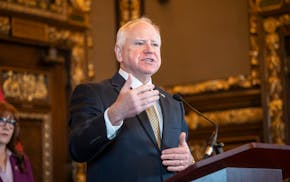Twin Cities homebuilders are bracing for the sting of tariffs on lumber and other materials at a time when new construction sales are on the rise, defying a national slump.
Those homebuilders offering steep discounts helped boost March sales in the area by 2.2% from the same time last year. That's the biggest gain of any of the 90 major metros measured and one of only four to see a sales increase, according to data research firm Zonda.
Yet those in the industry expect tariffs will make new houses more expensive, which could erase the recent bump. The National Association of Home Builders (NAHB) said tariffs could increase the average cost of a home by at least $10,900.
"The direct impact is really uncertain right now," said Dan Fulton, senior vice president at Zonda.
Fulton added home prices nationwide have remained stable as relatively low inventory has helped offset slowing demand.
In the Twin Cities metro, homebuilders are digging more foundations than they have in several months. But the total number of new houses and apartments slated for construction is down by more than half compared with three years ago. Builders are offering a variety of price discounts and financing incentives as a way to offset higher mortgage rates.
Last month, Twin Cities-area builders pulled 608 single-family permits, 12% more than last year, according to a monthly report from trade group Housing First Minnesota, which represents builders in the state. Multifamily construction, mostly market-rate rentals, was also up after several months of declines.
James Vagle, CEO of Housing First, said an exceptionally busy Parade of Homes spring preview, which ended April 6, has emboldened builders.
"We remain far from a balanced market," he said, noting there are more buyers than sellers in many parts of the metro, which attracts buyers who can't land a previously owned home to seek a new one.
Vagle has been spending a lot of time in St. Paul, lobbying Minnesota lawmakers to encourage laws that promote more housing development at a time when house prices and rents keep rising.
"Incentives are not a viable long-term solution; they are very much a market response to challenges for homebuyers," he said. "We need moderation in interest rates but also need more starter homes. It is critical that lawmakers keep meaningful housing solutions in play."
Nick Hackworthy, president and CEO of Woodbury-based Creative Homes, said a record number of people toured his company's model homes during the Parade of Homes. Home sales at his company were up during the first quarter compared with a year ago, and sales during the second half of March were the best in the company's history.
But during April, sales were a bit softer than last year, he said.
"The headlines and market volatility likely played a large role in that, causing pause and uncertainty for the consumer," he said. "… It's a great time to buy a home. There is a lot of headline-stirred fear with tariffs impacting housing, but the reality is, we have not experienced noticeable tariff impact on our costs or home prices."
After a couple of very small declines, mortgage rates flattened last week. As of Thursday, the 30-year fixed-rate mortgage averaged 6.76%, according to a weekly Freddie Mac survey. That was unchanged from the prior week and one-third of a percentage point lower than last year at this time.
"We are also seeing a lot of cash buyers that are not impacted by interest rates and see this as a great time to buy," Hackworthy said.
He said he and other builders are offering price reductions and interest rate buydowns that enable buyers to borrow at a slightly lower mortgage rate for move-in-ready homes
Lennar, the largest builder in the metro, is offering a nearly $56,000 discount on a $464,000 four-bedroom house in Zimmerman and a nearly $85,000 reduction on a house in Dayton.
The NAHB said in March, 29% of all builders offered price reductions. That's a slight increase from last year at the same time. About 59% of all builders offered some kind of sales incentives, which was about the same as last year.
Nationwide, homebuilding has contracted. During March, there were 650,355 new home sales on a seasonally adjusted annualized rate. This was a decline of 3.2% from the previous month and a 11.5% decline from a year ago.
Homebuilding varies dramatically from region to region. Several southern regions where homebuilding has been especially rampant have seen a decline in demand and an increase in listings, while demand for new houses in many parts of the Midwest outstrips supply.
Fulton attributes the Twin Cities metro's recent gains to solid job growth and a shortage of previously owned house listings.
"I would expect resale buyers who can't find what they want are incentivized to get the home they want, so they're upping their budget and getting into a new home," he said. "We will pay the price for tariffs down the road. Now, that hasn't shown in the [sales] numbers."
When Zonda polled builders in March 2024, 5% of them said demand is slower and causing concern. A year later, nearly 40% of them expressed such concerns.
Hackworthy said so far, his sales team is upbeat, even if many consumers are weary and feeling unsure. A lot of buyers, he said, are trying to brush aside those concerns and move forward.
"Buying a home is like planting trees," Hackworthy said. "The best time to do it was yesterday. The next best time is today."

Delta hiked fares for solo travelers, until Twin Cities travel experts caught the change

In first speech back, UnitedHealth's new CEO pledges to review hot-button issues

A child had measles at Mall of America, concerning state health officials who don't know source

Ramstad: Gov. Walz, things are not getting done in Minnesota

